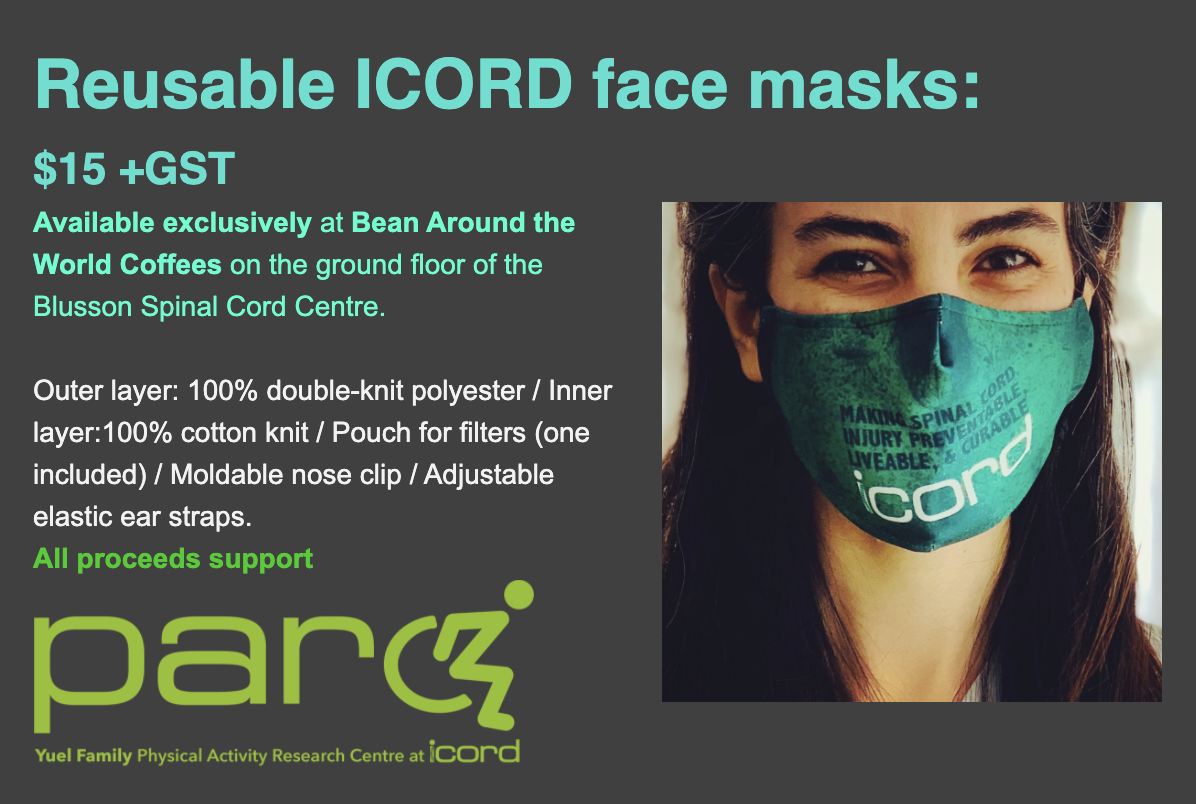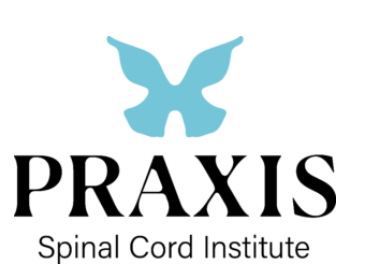
Dec 2, 2020

In honour of Fall Prevention Month (which just ended) we thought we’d delve into this topic for our Fall issue, and have some interesting stories lined up for you. And in case you’re wondering what it’s like to be working in a research lab in a pandemic, we catch up with two staff members who can tell you all about it. We’re also excited to bring you a new column by a PhD student showcasing the beauty of neuroscience. Plus: ICORD news roundup, studies you can do, partner news, and more. We hope you enjoy these stories:
by Jocelyn Chan
 ICORD researcher Dr. Carolyn Sparrey recently received a new female crash test dummy for use in her research, and her lab is one of the first research groups in Canada to own one. The Sparrey Lab studies impact biomechanics in wheelchair falls and is building computational models of falls in older adults. Purchased with the support of the Canada Foundation for Innovation, this new dummy will provide a source of validation and critical information on fall impact mechanics, which is important with falls becoming a leading cause of SCI in older adults.
ICORD researcher Dr. Carolyn Sparrey recently received a new female crash test dummy for use in her research, and her lab is one of the first research groups in Canada to own one. The Sparrey Lab studies impact biomechanics in wheelchair falls and is building computational models of falls in older adults. Purchased with the support of the Canada Foundation for Innovation, this new dummy will provide a source of validation and critical information on fall impact mechanics, which is important with falls becoming a leading cause of SCI in older adults.
Given the ethical limits on what is possible with live human participants in falls research, researchers need additional tools to explore impact mechanics during fall events and to understand how different injury prevention strategies from compliant flooring to hip protectors or headgear reduce impact forces and resulting injuries. The new female dummy will be used in several projects, mostly focused on older adult falls and developing a more biofidelic platform to test injury prevention strategies.
Test dummies were originally designed and calibrated for high speed car crashes, and were based on an average-sized man in the early 1970s (flat-chested, straight-hipped, 78kg, 175cm tall). A smaller-sized male dummy does not properly reflect female anatomy and resulting injury risk.
Dr. Sparrey and her team will be looking into ways to make this female test dummy more representative of lower intensity events like falls. Understanding and improving the accuracy of the contact properties (soft tissues) in these dummies for lower intensity events will allow dummies to more accurately mimic fall biomechanics and impact forces. Unlike high-speed crashes, soft tissues such as fat and muscle play an important role in absorbing energy and distributing impact forces during a fall and are not yet accurately simulated in these dummies. 
Besides its various general usages in fall mechanism research, one of the female dummy’s advantages will be its contributions to sex-related differences in injury research. The importance of sex differences is increasingly being recognized across many fields of research. However, injury biomechanics has traditionally paid less attention to sex difference, whether in laboratory experiments or computer simulations. This has important implications for safety and injury prevention. For example, a comprehensive review of automotive accidents by the Center for Applied Research at the University of Virginia found women were at significantly greater risk of injury than men in the same accident. They attributed these findings in part due to the use of male crash test dummies in safety testing and standards.
Like most research groups, the Sparrey Lab worked with a male dummy in the past. This 50th percentile male dummy was borrowed from the Applied Biomechanics Lab at the University of Washington.
“While female dummies exist, they are rarely used in research and not used at all in national testing standards,” said Dr. Sparrey. “However, the consequences on female safety and well-being by making policy and safety decisions based solely on male dummies are now being seen. This is yet another example of why it is so important to diversify who participates in engineering research as well as policy and standards decision making. Bringing diverse values and experiences to the table helps expand the consideration of research variables and factors that may be important but overlooked.”
The new dummy opens an important line of new research and provides a powerful research tool for many investigators across BC testing the efficacy of injury prevention methods and protective equipment. Dummies are complex and expensive (up to $300K or more) so having this resource available to share with other labs in BC makes it possible for many researchers to include sex-differences in their research.
By Rona Herzog
It probably goes without saying that 2020 has presented everyone with a multitude of challenges and adjustments. People in the world of research and academia faced an abrupt change to their working dynamics when COVID-19 restrictions went into effect in the spring, but over the summer and early fall, some restrictions have eased, and some people have returned to the lab. We thought for this Fall issue of the ICORDian, we caught up with two ICORD staffers to find out how they navigated the world of research during a pandemic. We spoke to Alison (Ali) Williams, the manager of Dr. Tania Lam’s Human Locomotion Lab, and Luis Dias, a research engineer in the Orthopedic Injury Biomechanics Group (OIBG).
 “Before the lockdown, I was quite busy in the lab, wrapping up a few studies and starting to collect pilot data for a new clinical trial,” said Ali. The lab was also starting some exciting collaborations both within, and outside of ICORD. Ali was out of the lab from mid-March until mid-June. She was able to work in the lab just a few times a month over the summer. Since October, she has been in the lab more regularly, “which means I’ve been able to revive a few projects,” she said.
“Before the lockdown, I was quite busy in the lab, wrapping up a few studies and starting to collect pilot data for a new clinical trial,” said Ali. The lab was also starting some exciting collaborations both within, and outside of ICORD. Ali was out of the lab from mid-March until mid-June. She was able to work in the lab just a few times a month over the summer. Since October, she has been in the lab more regularly, “which means I’ve been able to revive a few projects,” she said.
Luis’s work is primarily hands-on research (his projects involved biomechanical testing of cadaver spines). Just before the lockdown, Luis was focussing on making components and setting up custom testing equipment for a new set of experiments. “Unfortunately, this was not the kind of work I could do at home during the lockdown,” he said. Like Ali, Luis was able to return to the lab under ICORD’s stage one research resumption in June. His work schedule still remains very different than it was (he currently splits his time 50-50 between hands-on lab work and working from home).
During the lockdown, both Ali and Luis were able to work remotely. “I’m thankful that I was able to work from home effectively, despite the big adjustment from being at ICORD every day to being stuck in my apartment,” said Ali, who missed the close-knit collaborative atmosphere of the lab. Ali mentioned that the  group scheduled lunch and coffee breaks over Zoom so they still had a chance to catch up. Working from home did allow Ali to take a step back from her regular lab work, and instead focus on preparing manuscripts for completed projects. So far, three manuscripts have been submitted for publication and have another four papers are in preparation (go team!).
group scheduled lunch and coffee breaks over Zoom so they still had a chance to catch up. Working from home did allow Ali to take a step back from her regular lab work, and instead focus on preparing manuscripts for completed projects. So far, three manuscripts have been submitted for publication and have another four papers are in preparation (go team!).
Luis also took the time at home to work on some publications and data processing that had previously been on the backburner, “which was actually pretty refreshing. With that being said, I still missed doing hands-on research and seeing smiling faces at the lab. Work during lockdown was a lot more solitary, in comparison to the highly collaborative pre-pandemic work atmosphere,” he said.
With research at ICORD slowly starting back up, Ali and Luis were able to take a moment to reflect on what they enjoy about their work now (vs. pre-pandemic), as well as what they are missing.
“Working at a slower pace has been nice, but I’m still looking forward to the lab work picking up again,” said Ali. “During the lockdown, the lab started using Slack for virtual collaboration. Now we use it all the time to manage projects, and I imagine that will continue even once the pandemic is over.” Despite some of the positives of pandemic research and lab life now, Ali misses spending time with her fellow lab mates and ICORDians. “I’m really looking forward to the day we can all gather safely again!” she said.
Luis has been enjoying his new flexible work schedule and how much time he has saved by not commuting. There are also some positives to working with a smaller in-person group at the lab, including greater focus on the hands-on work and having fewer distractions. “Despite the lack of distractions, I used to enjoy seeing the lab packed with students, and really miss being able to see what everyone is working on,” he said. “Having fewer people working in the lab, you lose the impromptu brainstorming sessions and in-person lab meetings – Zoom just isn’t the same,” he added. “I hope that when we are past the pandemic, we can remember some of the positive lessons we’ve learned from working remotely, including appreciating some of the in-person aspects of research we may have previously taken for granted.”
Seth Holland is a PhD student in the lab of ICORD researcher Dr. Matt Ramer, and he has an eye for the artistic side of research. We’re excited to work with him on this new series showcasing some of the beautiful/interesting images he captures in the course of his research work.
Seth and his colleagues use a staining technique called immunofluorescence, in which they use designer antibodies that bind to a specific protein. They use a confocal microscope that uses lasers to provide a very specific wavelength of light onto the tissue. The antibodies in the tissue have a fluorescent molecule attached to them, and the microscope captures the light emitted from the molecules that are excited by the laser. 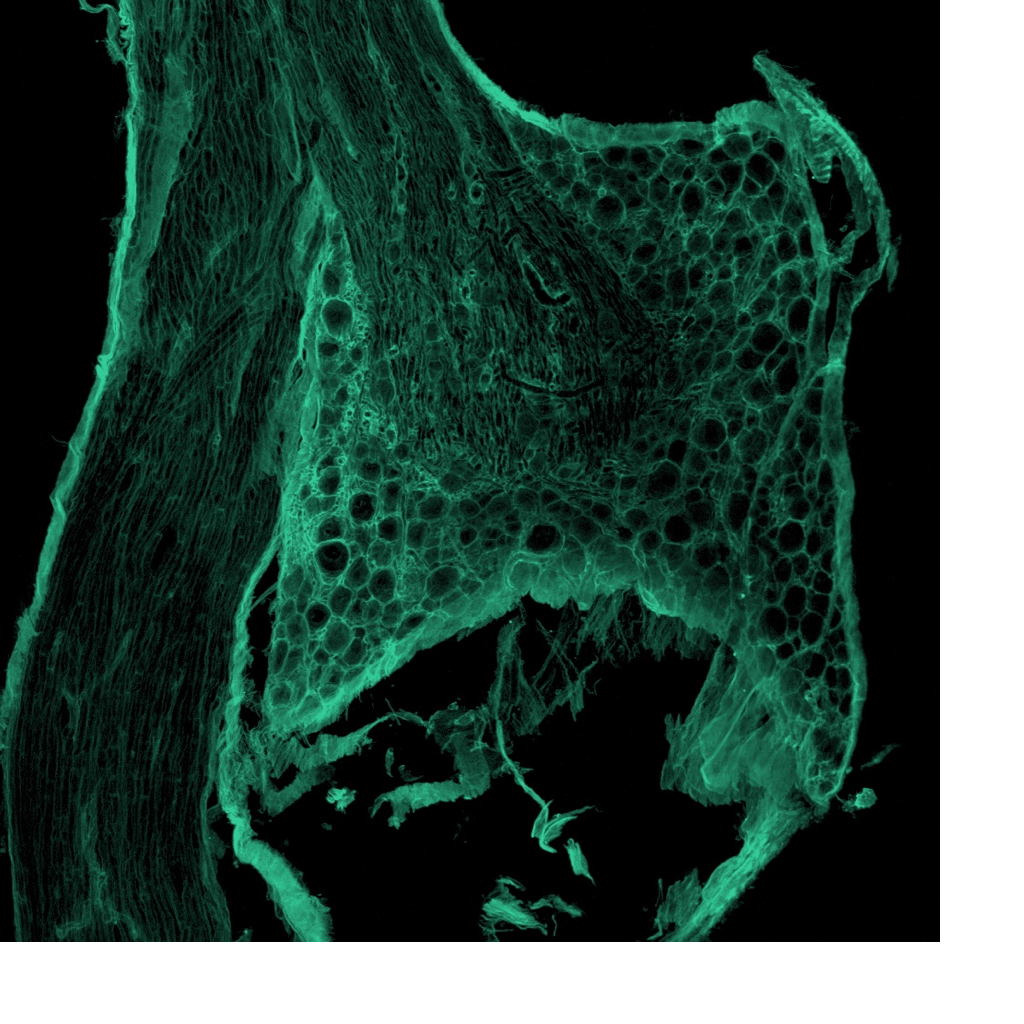 The images are captured in black and white (technically each pixel has a value that ranges from 0-255 that is based on the intensity of the fluorescent signal), and then they are falsely coloured (to look nice).
The images are captured in black and white (technically each pixel has a value that ranges from 0-255 that is based on the intensity of the fluorescent signal), and then they are falsely coloured (to look nice).
The bluey-green image to the left shows a dorsal root ganglion (or DRG). This is where the cell bodies of the neurons that first receive all types of sensory signals (pain, touch, temperature, etc.) from the body reside. One branch of the neuron extends into the peripheral nervous system to receive sensory information, while another extends into the central nervous system to relay that information to subsequent neurons. This image was taken to look at changes in expression of three specific proteins.
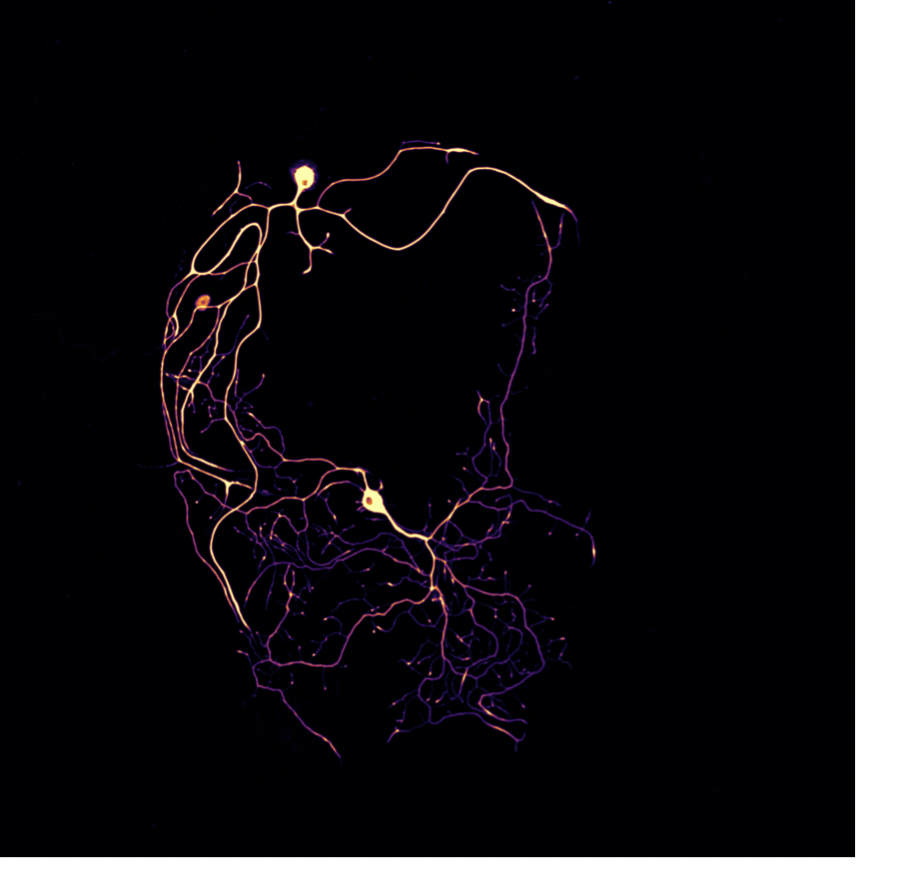 The purple and yellow image shows the very same neurons but as a primary cell culture. The DRG is dissected, the neurons are dissociated, and then plated in a culture dish, where under very specific conditions they will survive and even regrow their branches. This image was taken to see if a drug increased the amount, or rate of growth of these branches.
The purple and yellow image shows the very same neurons but as a primary cell culture. The DRG is dissected, the neurons are dissociated, and then plated in a culture dish, where under very specific conditions they will survive and even regrow their branches. This image was taken to see if a drug increased the amount, or rate of growth of these branches.
by Jocelyn Chan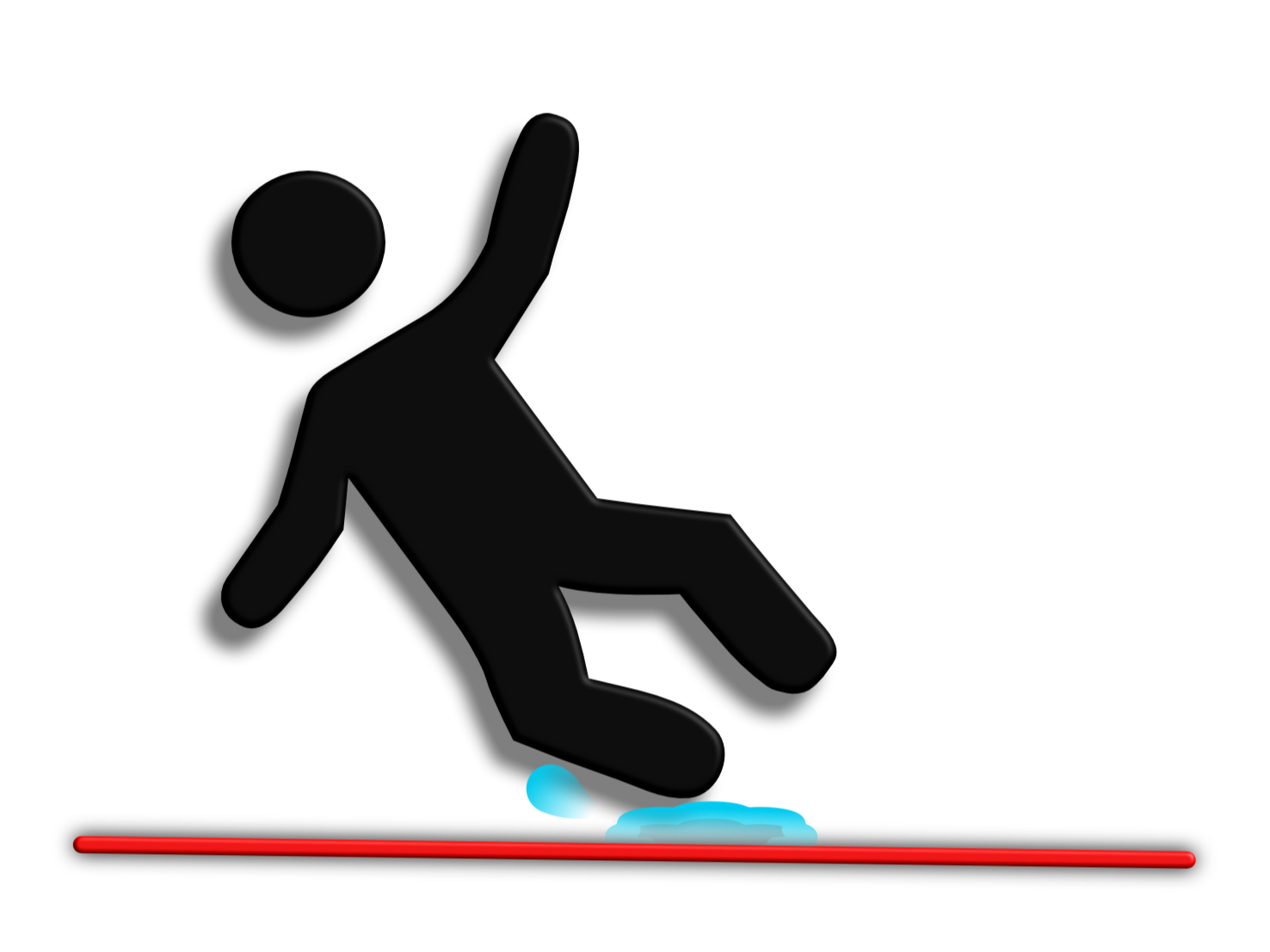
Did you know that the majority of spinal cord injuries (SCI) are due to preventable causes such as falls and road traffic crashes?
Falls are commonly cited as one of the top causes of all SCI, following motor vehicle crashes. Depending on the source you consult, the percentage of SCIs caused by falls in North America ranges from 16.5% to 32.5%. In fact, falls overtake motor vehicles with rising age and is the leading cause of SCI after age 45. Apart from causing SCI, falls are also responsible for many other injuries and are the number one cause of broken hips and head injuries.
Without prevention efforts, about one third of people in the general population aged 65 years and over typically fall at least once a year. Amongst rehabilitation patients with SCI, the incidence of falls is 13%. Seniors and people living with SCI are more prone to falls, so implementing fall prevention procedures is a critical top priority in Canadian hospitals. Fall prevention tactics that can help both the SCI and the elderly population include home improvements, improving mobility and health, and wheelchair-specific maneuvering techniques.
20% of fall-induced SCI are caused by tripping and slipping. Minimizing slip and trip hazards in your home and outdoor living spaces can help mitigate the risk of injury. Here are some home improvements for fall prevention:
 Install nightlights in hallways, bathrooms and bedrooms, and motion-sensitive lights to keep your main entrance well lit.
Install nightlights in hallways, bathrooms and bedrooms, and motion-sensitive lights to keep your main entrance well lit.- Clear floors of obstacles and clutter (e.g. electrical cords, loose rugs and carpets), especially from stairs and walkways.
- Remove raised door sills where possible

- Use non-slip mats in the shower and bathtub, as well as the bathroom and kitchen floor.
- Install grab bars in the bathroom and handrails on both sides of stairs.
- Maintain handrails, walkways and steps so that they are in good shape.
- Use coloured paint or non-skid tape to mark the edge of all stair steps.
- For more information, check out the Home Safety Checklist.
Falls from wheelchairs post-SCI lead to a significant number of hospitalizations. Here are some wheelchair-specific fall-prevention tactics:
Other wheelchair-specific fall prevention tactics include checking that the brakes are on before standing or sitting down. For more information, our partners at SCIRE Community have compiled a video playlist about wheelchair falls prevention.
Keeping physically active, eating a balanced diet low in animal proteins/fats and drinking alcohol in great moderation, and getting regular health checkups can also drastically reduce your risk of falls. 
ICORD’s Yuel Family Physical Activity Research Centre (PARC) offers free accessible and SCI-friendly online exercise classes that are open to everyone. Click here for details.
These are some things that happened at ICORD since the summer issue of the ICORDian was published:
$1 million prize
ICORD Associate Director of Clinical Research, Dr. Brian Kwon, is one of three winners of the inaugural Craig H. Neilsen Visionary Prize. Dr. Kwon and co-winners Andrea Dalzell and Reveca Torres, will each receive US$1 million for their distinctive contributions and demonstrated excellence in the world of spinal cord injury, in honour of late entrepreneurial leader Craig H. Neilsen. READ MORE
$48 million research grant
An international research team, co-led by Dr. Brian Kwon, received a $48 million grant (US$36.5M) for research that aims to improve long-term outcomes for patients with SCI. The five-year project—made possible through a grant from the United States Defence Advanced Research Project Agency (DARPA)—will revolutionize SCI treatments using innovative, implantable technologies. Dr. Kwon and his team at ICORD will share the grant funds with teams in Canada, the US, and Switzerland. READ MORE
Important publication
Dr. Christopher West and Dr. Brian Kwon and their research teams published a study in Nature Communications that challenges the current standard for managing blood pressure in people with SCI. The findings could lead to a change in the way newly injured patients have their blood pressure managed, potentially improving their chances of retaining more function in the long term. ICORD postdoctoral fellow Dr. Alex Williams is first author on the manuscript. READ MORE
New faculty position
In early September, Dr. John Kramer became an Assistant Professor (tenure track) in the UBC Department of Anesthesiology, Pharmacology, and Therapeutics.
READ MORE
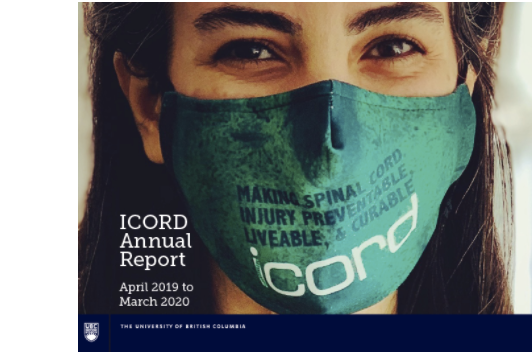
Annual report now available
ICORD’s annual report for the period of April 1, 2019 to March 31, 2020 is now available. Click here to download a copy.

Some updates by Femke Hoekstra
The IKT Guiding Principles
ICORD PI Dr. Heather Gainforth led the co-development of the first integrated knowledge translation (IKT) guiding principles for conducting and disseminating spinal cord injury research in partnership. These principles are co-developed using a systematic approach by a multidisciplinary team including SCI researchers, research users and funders. A paper describing the principles and the development process of the IKT Guiding Principles was recently published in Archives of Physical Medicine and Rehabilitation. More information about the project as well as involved team members (including many ICORD PIs and trainees) will be available here.
First results of the COVID-19 Disability Survey
A short report with preliminary findings of the COVID-19 Disability Survey is published on www.disabilitysurvey.ca. This nationwide survey measures the experiences, concerns and needs of Canadians with disabilities during the COVID-19 pandemic and recovery periods. The findings will provide important information to help Canadian communities ensure that COVID-19 response strategies meet the needs of people of all abilities. The project is led by the Abilities Centre (abilitiescentre.org) and the Canadian Disability Participation Project (cdpp.ca). The SCI Action Canada lab (ICORD PI Dr. Kathleen Martin Ginis) is currently preparing a full report of the survey findings.
Dr. Christopher West welcomed two new trainees
Liam Stewart’s masters project is to demonstrate the presence of a cardio-inotropic limb to the arterial baroreflex by performing informative integrative physiological studies in SCI injury models. His research will provide key insights into how the heart mounts the necessary inotropic response to maintain blood pressure homeostasis during physiological stress. He hopes that his research can be used to develop more targeted therapeutics to treat cardiovascular dysfunction in people with SCI.
Dr. Ryan Hoiland’s postdoctoral research focuses how we may improve the delivery of oxygen to the spinal cord in the acute phase following a traumatic SCI. By optimizing the management of blood pressure and the blood supply to the spinal cord, improvements in spinal cord oxygenation may lead to improved outcomes.


Interested in helping ICORD researchers make SCI preventable, livable, and curable? These research studies (and more) are in need of participants!
A behavioural support intervention to promote participation among family support providers of people with spinal cord injury
ICORD PI Dr. Heather Gainforth and PhD student Rhyann McKay are interested in evaluating the acceptability and usefulness of a brief one-on-one intervention aiming to promote participation among family members, partners, and friends who support someone with a spinal cord injury.
SCI research participants’ views on data sharing survey
ICORD PI Dr. Heather Gainforth and PhD student Rhyann McKay are interested in evaluating the acceptability and usefulness of a brief one-on-one intervention aiming to promote participation among family members, partners, and friends who support someone with a spinal cord injury.
The impact of COVID-19 on people with SCI and rehabilitation access
Currently there is a limited understanding of the impact of COVID-19 on vulnerable populations, such as the SCI community. In addition, people with SCI may be disproportionately affected by COVID-19 due to pandemic mitigation strategies focused around physical distancing, which interrupts access to caregiver support and rehabilitative services. This Krassioukov Lab study aims to determine the impact of the COVID-19 pandemic on the delivery of rehabilitation services towards people with SCI and their mental health.
Understanding the experiences of individuals with incomplete spinal cord injury who can walk
There is a growing number of individuals who have incomplete spinal cord injury (SCI) who are able to walk. Having an incomplete SCI comes with challenges including living with a potentially hidden disability, and there are questions about the suitability of programs for people with incomplete SCI (which were originally developed for people with complete SCI). Researchers in Dr. Mortenson’s lab want to identify the distinct needs and strengths of people with incomplete SCI who are able to walk, and explore potential supports, services and programs that would best assist this population to adjust, adapt, and thrive in the community.
Click here to browse all the ICORD studies currently recruiting participants.
 Did you know that volunteers at our SCI Community Resource Centre prepare summaries of scientific papers and post them on our SCInfo blog? If you’re interested in what’s going on in SCI research around the world, this is a good place to look.
Did you know that volunteers at our SCI Community Resource Centre prepare summaries of scientific papers and post them on our SCInfo blog? If you’re interested in what’s going on in SCI research around the world, this is a good place to look.
We are excited to introduce a new series of web comics created by Adam Mesa. What topics would you like to see?
SCI BC is continuing to offer our online events. From casual coffee groups to at-home workouts and board game nights – there is something for everyone! See the full list of activities on our events calendar: https://sci-bc.ca/events-
Virtual Peer Support
SCI BC has started a new playlist on our YouTube channel that includes videos from our online Peer Support groups on topics such as mindfulness, nutrition, research, etc. Here’s the playlist.
 Accessible Spaces 101
Accessible Spaces 101
The Rick Hansen Foundation and PowerED™ by Athabasca University (AU) are proud to launch Accessible Spaces 101! This self-paced online course helps participants identify barriers, examine the impact of the social and physical environment on people with disabilities, and provide insights in to how to create accessible spaces that are inclusive of all people.
On completion of the course, participants will understand how people with disabilities interact with the built environment, to communicate in a respectful and inclusive manner, and to apply universal design principles to designing, operating, and delivering services in physical spaces.
Course commences January 18, 2021.
Learn more & register your interest here. Not sure if this course is right for you? Attend an information webinar on December 10. RSVP here.
Three recent publications included Praxis authors.
- In-Hospital Mortality for the Elderly with Acute Traumatic Spinal Cord Injury
- Factors Associated with Recovery in Motor Strength, Walking Ability, and Bowel and Bladder Function after Traumatic Cauda Equina Injury
- Models of Care Delivery From Rehabilitation to Community for Spinal Cord Injury: A Scoping Review
Meet the Praxis SCI Incubate 2020 Cohort
Praxis Spinal Cord Institute is pleased to announce five transformative technologies following a worldwide call for innovations. Carefully selected by an expert panel of spinal cord injury (SCI) consumers, researchers, and commercial leaders, these five early-stage innovations address care- and cure-related treatments for people with SCI and have the potential to transform healthcare outcomes for the broader community. Learn more about the companies.

Thanks for reading this issue of The ICORDian – we hope you enjoyed it! Please subscribe and have future issues delivered to your inbox. If you have any comments about this issue or suggestions for future ones, please contact us.








